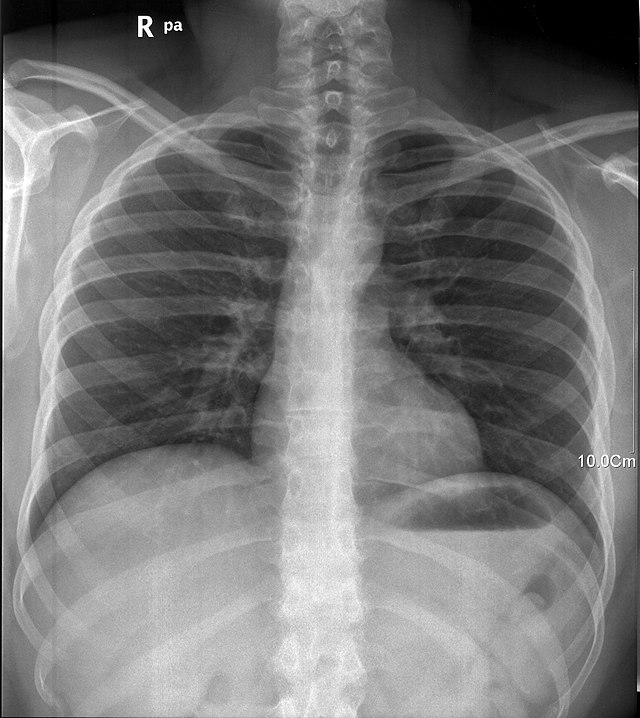X-ray
electromagnetic radiation of wavelength ranging from 10 pm to 10 nm From Wikipedia, the free encyclopedia
X-radiation is a kind of electromagnetic radiation. X-rays are waves of X-radiation. They have a shorter wavelength, and therefore more energy, than ultraviolet radiation. X-rays have a much shorter wavelength than visible light (the light that we can see). Radiation with shorter wavelengths (more energy) than the X-ray is called Gamma radiation (γ-rays). These are all parts of the electromagnetic spectrum.

The wavelength of X-rays covers a wide range. Most X-rays have a wavelength in the range of 0.01 to 10 nanometres. This corresponds with frequencies in the range 30 petahertz to 30 exahertz (3×1016 Hz to 3×1019 Hz) and energies in the range 100 eV to 100 keV.
X-rays can go through many solid materials. For this reason, taking photograms with X-rays is used in medicine in order to see bones and other things inside the body. Sometimes the term "X-ray" means these pictures instead of the radiation that makes them.
What these images show will depend on three things: Rayleigh scattering, Compton scattering and photoabsorption.[1][2][3] The images show bone because it is dense enough that X-rays are not able to pass through it. Instead, the X-rays are either absorbed or scattered. The images do not show skin and muscle, however, because these tissues are transparent enough for the X-rays to pass through them without being absorbed too much. To detect tumors, other imaging devices are used; such as magnetic resonance imaging. A computed tomography scanner combines an X-ray machine and computer to construct a three dimensional (3D) picture. This has some ability to see other things besides bone.
X-rays are made by hitting metal with fast-moving electrons. They are photons, tiny packets of energy that can move atoms and change chemicals in the body. They are ionizing radiation but the things they do depend on the wavelength of the X-rays (or how much energy they have). X-rays with smaller energies ("soft" x-rays) cause the photoelectric effect. Mid-level energies cause Compton scattering. High-level energies ("hard" X-rays) cause pair production. X-rays used for making pictures of people have low to medium energy. Radiation therapy that treats cancer uses Compton scattering and sometimes Pair production.
There are small amounts of X-rays in the air. Like other energy in the air, X-rays can change living cells. Exposing the human body to high doses of X-rays for a long time is dangerous. It can cause cancer. However, cancer cells are hurt more easily, so X-rays are sometimes used to kill them.
Related pages
References
Wikiwand - on
Seamless Wikipedia browsing. On steroids.
